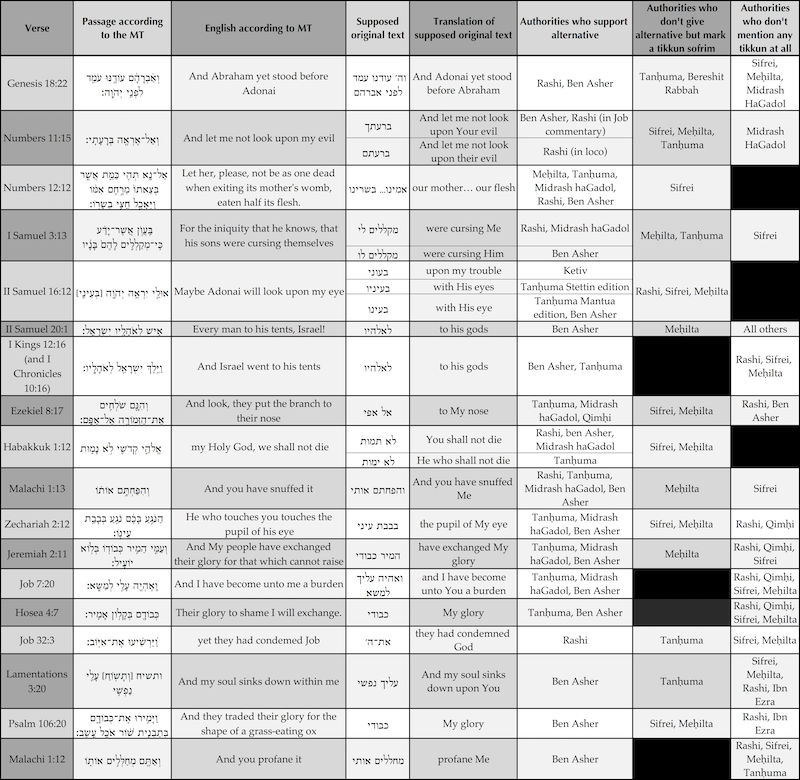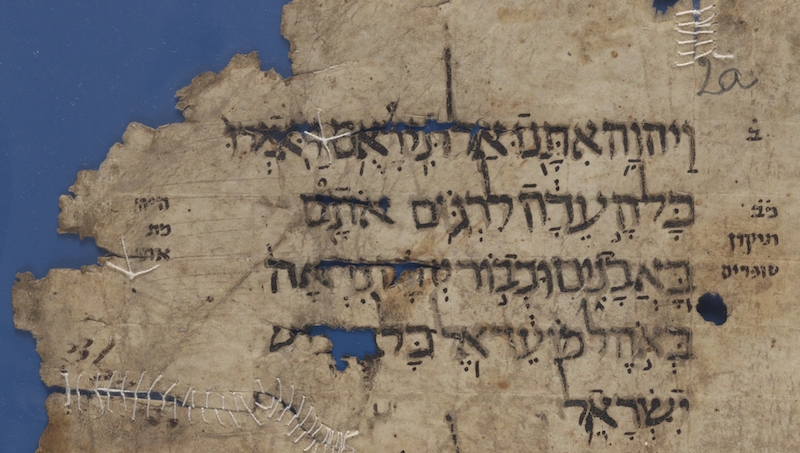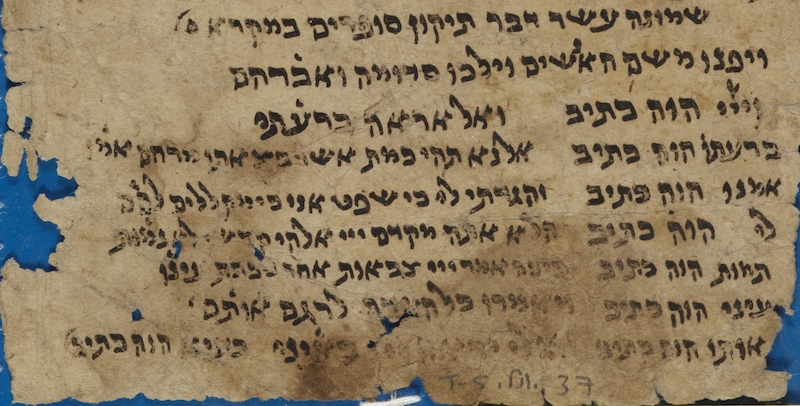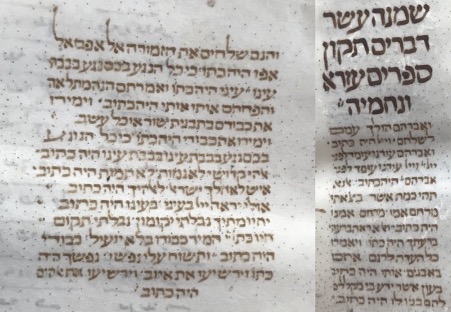New Tiqqunei Soferim: T-S A4.10 and T-S D1.37
Over the course of my stay at Cambridge investigating the Masorah of Hebrew Bible manuscripts from the Genizah, I became increasingly convinced that there is a wealth of important Masoretic material still locked away in the Genizah. This is in no small part due to the nature of the Masorah itself, which is often communicated by intricate micrography, terse and abbreviated lists, and marginal scribbles. This presents a serious obstacle when it comes to the Genizah, where rubbed out or faded ink, illegibility, and torn edges are ubiquitous.
One of the most celebrated and infamous topics relating to the Masorah is the Tiqqunei Soferim, or “emendations of the scribes”. The Tiqqunei Soferim are a group of words that are deliberately written in the Masoretic Text differently than intended, in order to protect the honor of God. Whether these instances are indeed emendations by an early group of scribes (a term often referring to the biblical figures Ezra and Nehemia) or just euphemisms employed by the original authors of the text is a controversy that is as old as the Tiqqunei Soferim themselves, with some sources employing the term “tiqqun soferim” – “emendation of the scribes”, and others the term “kinnah hakatuv”, or “the text is euphemistic” (a less contentious interpretation, as it does not imply that the biblical text was actually tampered with).1
The number of Tiqqunei Soferim is most commonly given as 18, though there are some sources that list fewer.2 While there is considerable overlap between the different traditions, there is not full agreement regarding what the 18 instances are, resulting in about 25 variants altogether.3 In this article, I will introduce four new variants: Numbers 14:10 (discussed at length), Genesis 18:16, Isaiah 26:19, and Exodus 32:7.
There are a variety of different sources that list the Tiqqunei Soferim, ranging from important Midrashic compilations such as Mekhilta and Sifre, to Masoretic treatises such as Oklah we-Oklah4 and the expanded recension of Aaron Ben Asher’s Dikdukei Hate'amim,5 to the polemic works of the Karaite Jacob Al-Qirkesani6 and the Christian Raymond Martini.7 Intriguingly, the Tiqqunei Soferim are not mentioned anywhere in the primary manuscripts associated with the Ben Asher tradition of the Masoretic text (the Aleppo and Leningrad codices), although they are noted in many other important Bible manuscripts, such as the Cairo Codex of the Prophets and the Codex Babylonicus Petropolitanus. Here is a chart of the “standard” 18 Tiqqunei Soferim, as corroborated by many different sources:8

Table from Wikimedia Commons: Isaacmayer9, CC BY-SA 4.0 <https://creativecommons.org/licenses/by-sa/4.0>, via Wikimedia Commons
T-S A4.10 is, at first glance, an unremarkable fragment of the Hebrew Bible. It consists of three leaves, each containing two 18-line columns of mutilated and overwritten text. Covering an early portion of Numbers, it is marked with standard Tiberian pointing and cantillation, with several Masoretic notes supplied throughout.9 Yet in the margins of the second leaf (recto) we find a remarkable Masoretic note regarding the Tiqqunei Soferim.

Detail from T-S A4.10 P2, recto
Numbers 13–15 recounts the saga of the spies. While camping in the desert, Moses sends spies to scout out the land of Israel in order to strategize on how best to conquer it. The spies, encountering strong people and fortified cities, return and accuse Moses of attempting to lead the people into a slaughter. Caleb and Joshua, two of the spies, try to convince the people that they are capable of the conquest, but the population turns on them.
Numbers 14:10 reads:
וַיֹּֽאמְרוּ֙ כָּל־הָ֣עֵדָ֔ה לִרְגּ֥וֹם אֹתָ֖ם בָּאֲבָנִ֑ים וּכְב֣וֹד יְהוָ֗ה נִרְאָה֙ בְּאֹ֣הֶל מוֹעֵ֔ד אֶֽל־כָּל־בְּנֵ֖י יִשְׂרָאֵֽל׃
“The whole community said to pelt them with stones, and the glory of the Lord appeared in the Tent of Meeting to all the Israelites.”
The small circle (circulus Masoreticus) above the word אֹתָ֖ם (“them”) points to a Masoretic note in the margin of the text which reads (to the right of the text) כ׳ב׳ תיקון סופרים and (to the left) היה כת אתי. Meaning, originally the verse had been written “to pelt me (אתי) with stones” instead of “them” (אתם) – an instance of Tiqqun Soferim, of which there are a total of 22.10 The two aspects of this note, that of the emendation itself and that of the number 22, deserve individual analysis.
Numbers 14:10 is, to the best of my knowledge, a previously unknown variant of the Tiqqun Soferim phenomenon. It is not listed in any of the standard lists of Tiqqunei Soferim, nor in any of the previously published works discussing the Tiqqunei Soferim in particular and Masoretic studies in general.11 Standing on its own though, Numbers 14:10 perfectly matches the characteristics of a genuine Tiqqun Soferim: though the original intention of the text was that the people threw stones at God, the text was changed to imply that the people threw stones at Caleb and Joshua, in order to protect the honor of God. Moreover, in many of the Tiqqunei Soferim, the emendation is only of a single letter, and we find that here, too: the pronominal suffix Yod was switched to Mem, changing the word from the first person singular to the third person plural, from “me” to “them”.12 The language employed by the note, “it was written” (היה כת) is very similar to that of several Tiqqunei Soferim compilations as well.
We find this same Tiqqun Soferim in another fragment from the Genizah: T-S D1.37 (recto). T-S D1.37 is a fragmented and well-worn compilation of masoretic material. Written on paper, it contains about 23 lines of faded text.13 In terms of content and order, the material is very similar to the expanded recension of Ben Asher’s Dikdukei Hate'amim, as well as the lists that are often found at the beginning and end of Masoretic Bible manuscripts.14

Detail from T-S D1.37, recto
The list of the Tiqqunei Soferim is incomplete, being cut off by the end of the page, leaving a count of eight.
“18 words emended by the scribes in Scripture”:
1. Gen. 18:22 2. Num. 11:15 3. Num. 12:12 4. 1 Sam. 3:13
5. Hab. 1:12 6. Zech. 2:12 7. Num. 14:10 8. 2 Sam. 16:12
Item number 7, Num. 14:10, matches the Tiqqun Soferim noted by T-S A4.10. Once again, we find use of the expression “it was written” (היה כתיב) employed when discussing the Tiqqunei Soferim.
Fascinatingly, the idea encapsulated by this Tiqqun Soferim – that of the people attempting to throw stones at God – is preserved in the Babylonian Talmud (Sotah 35a), with similar analogs in Midrashic tradition:15
ויאמרו כל העדה לרגום אתם באבנים וכתיב (במדבר יד, י) וכבוד ה׳ נראה באהל מועד אמר רבי חייא בר אבא מלמד שנטלו אבנים וזרקום כלפי מעלה
"The verse states: ‘The whole community said to pelt them with stones,’ and it is written afterward: ‘and the glory of the Lord appeared in the Tent of Meeting to all the Israelites.’ Rabbi Hiyya bar Abba says: this teaches that they took stones and threw them upward (as if to throw them at God)." Interestingly, none of these Midrashic sources add that this is an instance of Tiqqun Soferim.16
From a contextual perspective, an original reading of “me” in the first person seems highly unlikely, as the narration of the story takes place entirely in the third person. This would support the conclusion of W. E. Barnes and many others who write that the Tiqqunei Soferim are not a Masoretic phenomenon, but a Midrashic one.17 Similar to the interpretation implied by the use of the expression “kinnah hakatuv”, the Tiqqunei Soferim are not real emendations that were made to the biblical text, but a Midrashic compilation of words that were interpreted to be euphemistic.
On the other hand, this very idea – that an original reading of “me” is contextually untenable – may be related to the fact that Numbers 14:10 is not included in the standard list of 18 Tiqqunei Soferim. Perhaps the Tiqqunei Soferim were refined at some point to only include instances that make sense as actual emendations, and thus Numbers 14:10 was struck from the list. Intriguingly, T-S A4.10 states that there are a total of 22 Tiqqunei Soferim, which I will return to later.
I was curious to see if I could find evidence of this new instance of Tiqqun Soferim outside the Genizah, but after looking through several dozen biblical manuscripts, I could only find the standard list of Tiqqunei Soferim. I did eventually find another source for Numbers 14:10 being a Tiqqun Soferim – but only accidentally, when I was browsing some photographs I had taken of biblical manuscripts housed at the Wren Library, Trinity College, Cambridge. Funnily enough, it turns out all the manuscripts (that I know of) that contain Numbers 14:10 as a Tiqqun Soferim are housed at Cambridge.
Ms. F.12.106 is a beautiful, complete Bible (bound in a single volume), written on vellum during the 13th century.18 Each page consists of two columns written in a Sephardic hand, with Masorah Magna and Masorah Parva occupying the margins. It is filled with intricate designs and micrography. The back of the volume contains several Masoretic lists, again similar to the expanded recension of Ben Asher’s Dikdukei Hate'amim and the material that bookends many Masoretic Bibles.19

Details from Wren Library, Ms. F.12.106 (The author is grateful to the Master and Fellows of Trinity College, Cambridge)
“18 words emended by the scribes Ezra and Nehemia”:
1. Gen. 18:16 2. Gen. 18:22 3. Num. 12:12 4. Num. 11:15
5. Num. 14:10 6. 1 Sam. 3:13 7. Ezek. 8:17 8. Zech. 2:12
9. Mal. 1:13 10. Ps. 106:20 11. Zech. 2:12 (duplicate)
12. Hab. 1:12 13. 2 Sam. 20:1 14. 2 Sam. 16:12 15. Isaiah 26: 19
16. Jer. 2:11 17. Lam. 3:20 18. Job 32:3
Besides corroborating the two Genizah fragments that there is indeed a tradition of Numbers 14:10 (#5) being a Tiqqun Soferim, this list introduces two entirely new cases of Tiqqunei Soferim as well: Gen. 18:16 (#1) and Isaiah 26:19 (#15). In general, the language used is nearly identical to that of T-S D1.37, once again employing the expression “it was written” (היה כתוב).
Genesis 18:16 reads:
וַיָּקֻ֤מוּ מִשָּׁם֙ הָֽאֲנָשִׁ֔ים וַיַּשְׁקִ֖פוּ עַל־פְּנֵ֣י סְדֹ֑ם וְאַ֨בְרָהָ֔ם הֹלֵ֥ךְ עִמָּ֖ם לְשַׁלְּחָֽם׃
".The men arose from there and looked toward Sodom, and Abraham was walking with them to send them off”
According to this Tiqqun Soferim, the true intention of the text is that “the Lord was walking with them to send them off.” Presumably, Abraham was substituted for God in the text in order to obscure the theological difficulty implied by God “walking”.20
Isaiah 26:19 reads:
יִֽחְי֣וּ מֵתֶ֔יךָ נְבֵלָתִ֖י יְקוּמ֑וּן הָקִ֨יצוּ וְרַנְּנ֜וּ שֹׁכְנֵ֣י עָפָ֗ר כִּ֣י טַ֤ל אוֹרֹת֙ טַלֶּ֔ךָ וָאָ֖רֶץ רְפָאִ֥ים תַּפִּֽיל׃
“Your dead will live, their corpses will arise! Awake and shout, dwellers of the dust! For the dew of herbs is your dew, and the earth shall cast forth the dead.”
This verse is grammatically problematic. The word “נְבֵלָתִי” is a singular, feminine noun meaning “my corpse,” but the word “יְקוּמוּן” is a plural, masculine verb meaning “they will arise.” To resolve this issue, many translate “נְבֵלָתִי” as “their corpses” (as I translated above),21 which is certainly contrived. According to this Tiqqun Soferim, the true intention of the text is: “Your dead will live, my corpse will arise...” (in Hebrew, “תקום”, a singular, feminine verb, matching “נְבֵלָתִי”). However, God referring to “my corpse” was clearly seen as very theologically problematic. Thus, the plural verb “יְקוּמוּן” was substituted, changing the meaning from “my corpse will arise” to the grammatically forced “their corpses will arise” – now referring to the corpses of Israel in place of the “corpse” of God.22 Here we find a Tiqqun Soferim that remedies a grammatical issue – the difficult “יְקוּמוּן” is in fact a euphemistic substitute.23
I would like to note one other previously unknown Tiqqun Soferim variant. The National Library of France, Ms. hebr. 769 is a miscellany from the 15–16th centuries written in a Sephardic hand. On pages 74a–75b, the author lists the Tiqqunei Soferim. Item number 18 describes an emendation to Exodus 32:7.
Exodus 32:7 reads:
וַיְדַבֵּ֥ר יְהֹוָ֖ה אֶל־מֹשֶׁ֑ה לֶךְ־רֵ֕ד כִּ֚י שִׁחֵ֣ת עַמְּךָ֔ אֲשֶׁ֥ר הֶעֱלֵ֖יתָ מֵאֶ֥רֶץ מִצְרָֽיִם׃
“And the Lord spoke to Moses: ‘Hurry down, for your people, whom you brought out of the land of Egypt, have acted corruptly.’”
According to this Tiqqun Soferim, the intention of the text is “my people” (עמי).24 However, the phrase “my people...have acted corruptly” was likely seen as disrespectful towards God, and so the pronominal suffix Yod was switched to Kaf, changing the expression from “my people” (first person) to “your people” (second person), referring to Moses in place of God.25
As far as the number 22 is concerned, T-S A4.10 is the only source that I am aware of to provide this total. Interestingly, it may be possible to consolidate the total number of Tiqqun Soferim variants down to about 22 – some of the differences between the various Tiqqunei Soferim traditions are how to count duplicate verses such as 1 Kings 12:16 and 2 Chron. 10:16. If one counts duplicate verses as only a single instance of Tiqqun Soferim, and verses that contain more than one emendation (e.g. Num. 12:12 in many traditions, see the chart above) as one Tiqqun Soferim as well, the total number of Tiqqunei Soferim that are corroborated by multiple sources is narrowed to about 22. Was there an original, unified list of Tiqqunei Soferim containing 22 words? It’s impossible to say for sure, but I think the appearance of the number 22 in T-S A4.10 makes this an enticing possibility.
It is often in the forgotten and overlooked that the greatest treasures are found. This is what makes the Genizah – a trash heap transformed into a treasure – so special. I think the greatest evidence that the Genizah is still very much alive, more than a century after its discovery, that it is still thriving and bursting with insight, is that new discoveries are being made from fragments that have already been catalogued, described, and dispensed with. In the tiny, abbreviated notes scrawled in the margins of forgotten fragments, there are still treasures waiting to be found. With dedication and time, we can surely uncover them.26
Footnotes
1 e.g. Exodus Rabba 13 and Genesis Rabba 39 employ the first expression. Mekhilta Shirah 4 (ed. Horovitz, p. 135, ed. Lauterbach II, p. 43) and Sifre I 84 (ed. Horovitz, p. 81) employ the second.
2 Tanhuma Exodus 16 lists 11.
3 For a relatively comprehensive list, see Moshe A. Zipor, Tradition and Transmission, Studies in Ancient Biblical Translation and Interpretation (Heb.), 2001, pp. 114–115.
4 S. Frensdorff, Ochlah W’Ochlah, Hanover, 1864, §168. This material is not present in the Halle codex of Ochlah W’Ochlah.
5 S. Baer and L. Strack, Dikduke Ha-Teamim, Leipzig, 1879, §6, cf. Aron Dotan, The Diqduqe Hatteamim of Aharon Ben Mose Ben Aser, Jerusalem, 1967, who discusses the expanded recension vs. the original.
6 Kitāb al-Anwār wal-Marāqib (کتاب الانوار والمراق), in Hebrew, Sefer ha-Me'orot, or Sefer ha-Ma'or. See L. Nemoy, Kitab al-Anwar wa-al-Maraqib, New York, 1939, pp. 151–161.
7 Pugio Fidei Raymundi Martini Ordinis Prædicatorum Adversus Mauros et Judæos, ed. Carpzov, pp. 694–695.
8 This chart can be found at https://en.wikipedia.org/wiki/Tiqqun_soferim.
9 Specifically, the text covers Numbers 11:31–12:2; 12:16–13:11; 14:3–27; and 17:6–18:3. The size of the leaves are 32.50 × 29.20 cm; 32.60 × 29.30 cm; and 32.70 × 14.00 cm respectively.
10 The final letter of the final word in the left margin is difficult to read. Originally, I thought it may have been a Waw, and indeed, אתו (“him”) would make more sense contextually, as it is in the third person. However, after finding several sources (discussed shortly) that write אתי with a Yod, it’s clear that a Yod is intended here as well.
11 Most notably, it is not mentioned in Carmel McCarthy’s foundational thesis regarding the Tiqqune Soferim. See Carmel McCarthy, The Tiqqune Sopherim and Other Theological Corrections in the Masoretic Text of the Old Testament (Orbis Biblicus et Orientalis, 36), Freiburg-Gottingen, 1981.
12 Though Gen. 18:16, for example, despite being a standard Tiqqun Soferim, amends much more than a single letter.
13 The fragment measures about 18.10 × 13.30 cm.
14 The list of Tiqqunei Soferim is juxtaposed by similar Masoretic treatises, that of the authors of each biblical book, and that of the years covered by each biblical book.
15 e.g. Numbers Rabba 16, Tanhuma Numbers 12.
16 Unlike, for example, Gen. 18:16, where several Midrashic sources (e.g. Genesis Rabba) explicitly state that the verse is one of the Tiqqunei Soferim.
17 W. E. Barnes, "Ancient Corrections in the Text of the Old Testament", JThS 1 (1899-1900), 387–414. Reprinted in Sid Z. Leiman, ed., The Canon and Masorah of the Hebrew Bible, 1974, pp. 379–414.
18 My thanks to Dr. Nicholas Bell of Trinity Library, who graciously provided me with these details. This manuscript is number 21 (W 58) in Loewe’s catalogue, where it is described at length. Another manuscript, British Library Ms. Or. 2201, is very similar to this one, but does not seem to contain a list of the Tiqqunei Soferim.
19 Just like in T-S D1.37, the list of Tiqqunei Soferim is juxtaposed by similar Masoretic treatises, that of the authors of each biblical book, and that of the years covered by each biblical book.
20 The similarities between this Tiqqun Soferim and the standard one of Gen. 18:22 (given in this manuscript as item number two), where Abraham is also substituted for God (and vice versa), are evident. I think it is quite possible that the two verses were accidentally interchanged due to their similar wording, resulting in this new variant. Moreover, it is not clear for what Midrashic purpose this Tiqqun Soferim would have been introduced in the first place – contextually, there doesn’t seem to be any difficulty in saying that Abraham was indeed the one walking. Thus, this Tiqqun Soferim would perhaps support the hypothesis that the Tiqqunei Soferim are real emendations that were made to the text.
21 Following the Syriac and Targum translations.
22 According to this Tiqqun Soferim, it is curious why the word תקומון (plural and feminine) was not substituted instead, as this would match נְבֵלָתִי in terms of gender. Also interesting is why the word נְבֵלָתִי was not changed to the third person plural נבלתם (“their corpses”) in order to match the verb יְקוּמוּן. Perhaps it was desirable to emend as little as possible. Notably, the list in Ms. F.12.106 uses the expression “they were written” (היו כתוב) only by the emendation in Isaiah, so perhaps this Tiqqun Soferim includes more that what is written in this manuscript (where only the word יְקוּמוּן is modified).
23 For an in-depth analysis of this verse, see Philip C. Schmitz, “The Grammar of Resurrection in Isaiah 26:19a–c,” JBL 122/1 (2003), pp. 145–155.
24 The issue of why the term “your people” was employed here by God is discussed at length in Midrashic literature. In particular, cf. Exodus Rabba 42:6.
25 The other Tiqqunei Soferim in this list are standard. Though neither of the emendations proposed earlier for Genesis 18:16 and Isaiah 26:19 are of a single letter (which is the most common type of emendation), this one (for Exodus 32:7) is.
26 Much appreciation is due to Dr. Ben Outhwaite, who was very helpful with the research and proofreading of this article (especially regarding the Genizah fragments), and Dr. Kim Phillips, who helped with the proofreading as well. I would also like to thank the entire staff at the Genizah Research Unit for being incredibly accommodating and helpful during my stay.
If you enjoyed this Fragment of the Month, you can find others here.
Contact us: genizah@lib.cam.ac.uk
The manuscripts in this article are part of the Cairo Genizah Collection in Cambridge University Library. To see more items from this collection visit: https://cudl.lib.cam.ac.uk/
